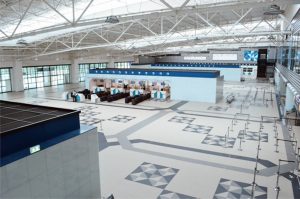Mr. John Attafuah is the Managing Director, Ghana Airports Company Limited, who is at the centre-stage of efforts to transform Ghana’ aviation infrastructure. He enthuses about the milestone improvement at the Kotoka International Airport, and the airport’s new Terminal 3 set to light up Ghana’s aviation landscape when it opens in August 2018. He speaks of Ghana’s successful Airport City, and other efforts to enhance Ghana’s positioning as a preferred regional hub.
Q: Airports are critical in the development of aviation in Africa, given the current trends. What is your vision for airports in Ghana?
A: The government has set itself the vision to make Ghana the hub of aviation for West Africa. To have that, we need to have very modern, functioning and efficient airports with all the modern facilities that will allow the airplanes and the airlines quick turn-around, quick facilitation of passengers, and efficient systems.
Kotoka is almost ready for that and we think that by August it should be ready to go live. We are also working out plans for the development of the Kumasi Airport to also make it international. We are also on the verge of concluding the contract for the Phase 2 of Tamale Airport, to make it international.
So the thing is to have enough aerodromes around here that will ensure that aircraft can come in, not only to Kotoka but to other places and ensure that they feed. To have the hub, you must be able to provide the feed. And we think that with all these airports in place, we will be able to do that more efficiently. That is where we are moving to, to ensure we have not only one but at least two or three major international airports in the country by 2020.
Q: Can you throw more light on the Terminal 3 that has been developed?
A: Terminal 3 is a modern terminal designed to handle 5 million passengers per annum. Terminal 2 was for 2.5 million passengers and we’ve already hit 2.7 so clearly we’re beyond the limit. Terminal 3 is for 5 million. It has 6 boarding bridges which are expandable to 8. It can handle code F aircraft so we think that the 747s and the A380s can all use our boarding bridges now.
We have 4 carrousels, expandable to 6. Two of them can handle two wide-body aircraft easily. We have modern baggage handling systems – auto-sorts luggage so that they don’t get missing, but get them to the right places. We have about 26 check-in desks which means checking in is going to be much easier; and there is enough space for shops, duty-free and food courts. We will also have the modern e-gates there. We are going to have commercially important persons lounge where those who want to pay can pay and get the services they want.

KIA Terminal 3 has state-of-the-art facilities to cater for 5 million passengers
Q: A number of African countries have hinted interest in the Airport City concept. But it seems you have implemented the Airport City in Ghana. Can you give an overview on how you were able to do that, what you have achieved and the future?
A: We think that we have now made the Airport City a go-to place for big business, and that is the place that every major corporate body now wants to have its address. We think we’ve done well in that regard. We have hotels, offices, banks, restaurants and everything there operated by the private sector. Some of them are in partnership with us, but most of these businesses are by the private sector.
We also intend to develop Airport City 2, using the experiences we learn from here. And we hope that it will be bigger and much better designed than Airport City 1. In doing that we hope to improve our non-aeronautical revenues, because aeronautical revenue depends on volumes, if we get more aircraft coming in, then, clearly, we can make more money. But we think that if we develop the Airport City concept, we will be able to raise non-aeronautical revenues. We intend to have one in Kumasi which will go in tandem with the new terminal development.
Q: Some businesses have complained about the cost of using the airport facilities in the region. How do you see your costs for businesses and airport city users, can one say they are not prohibitive?
A: Most of our spaces are over-subscribed. And now we are under pressure. A lot of people want to take our spaces. So we don’t think we are pricing ourselves out of the market. But of course, there are limits to how far you go.
Q: Would you talk about visa fee; would you say this and airport charges are a challenge to visitors?
A: Visa fees are not something that we do much about. But for the things that we can control, like the services we provide to airlines, for example ground lighting, etc., the fees we charge are very competitive.
When it comes to Air Passenger Service Charge, it is a government tax; it is not an airport charge. For those ones we can’t do much about them, unless we want to lobby government. But for the things that we control, I think we are very competitive about them.
Q: How ready are you for the Single African Air Transport Market (SAATM), what are your preparations?
A: We are very ready. Any day or anytime any airline wants to come in, we are ready to help them. We’ve been very cooperative. Just last month, Air Namibia, after four years, came back to Accra, to begin operations again.
One of the challenges we’ve faced with some of these operators is that they default in payment for the services we render them. There are airlines that now can’t come to Accra because they owe Ghana Airports a lot of money. And for those reasons we need to be very careful on who we allow in and the systems we operate to collect our fees.
Q: How would you describe the relationship among airports in the region in terms of competition and collaboration?
A: We are doing both. All of us need to be able to sustain our businesses and so we should be able to attract businesses. And in that sense we are likely competing. But in terms of services and support for each other as airports, we’ve done a lot of that.
We worked with Lagos when they went through their certification; some of our team members were there. They also came to see what we have done. Together we were able to get the Murtala Muhammed International Airport certified. We’ve done the same thing for Monrovia. We’ve worked with Airports of Uganda. And currently in the construction of our Terminal 3, we are working closely with Airports Company South Africa. They’ve been our major supporters and helped us in many ways. And now that we are undergoing ORAT – Operational Readiness and Airports Transfer phase, ACSA is here to support us.
Q: In five years time, where will you be?
A: We will be on top of the world.

